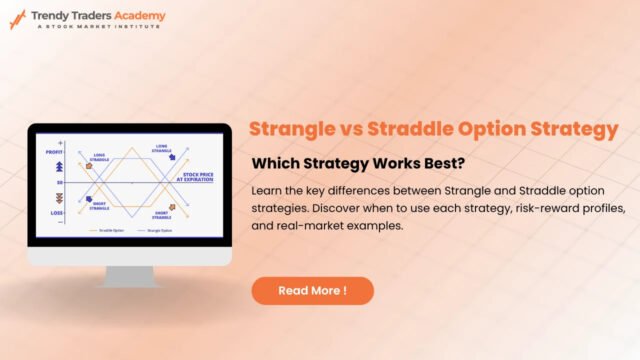Strangle vs Straddle Option Strategy: A Beginner’s Guide to Smarter Stock Trading
Have you ever felt like the stock market is a game of chess where every move matters, but you’re not sure which piece to play? If that’s you, you’re not alone! The world of options trading can seem like a maze, but two “moves”—the strangle option strategy and the straddle strategy—make playing the market both exciting and potentially profitable, even for everyday investors. Let’s break these down together, using simple language, relatable stories, and some expert tips that’ll make you feel like a pro.
Explore strangle option strategy, straddle strategy, and how stock trading courses can help you master these simple, powerful tactics for smarter investing
Introduction to Options Trading
Let’s start at the very beginning: an option is a contract giving you the choice (but not the obligation) to buy or sell a stock at a specific price by a certain time. Unlike buying stocks outright, options let you place strategic bets on market direction or even big moves, whether you expect prices to soar, tumble, or just wildly swing.
What Are Option Strategies?
Option strategies organize multiple options contracts into patterns that increase your odds of winning—or at least limit your losses. Sort of like playing both offense and defense in a game, these strategies can suit all types of market moods: up, down, or uncertain.
Why Use Option Strategies?
- To profit from volatility
- To hedge (protect) your investments
- To reduce risk with limited capital
Think of it like having an umbrella for rain and sunscreen for sun—you’re ready for anything!
Meet the Straddle Strategy
So, what’s the deal with a straddle? The straddle strategy involves buying both a call option (hoping the price goes up) and a put option (hoping the price goes down) on the same stock, with the same strike price and expiration date.
How Does It Work?
Imagine you believe a big event—say, a company’s earnings announcement—is going to shake up its share price, but you don’t know which way it’ll go. With a straddle, you’re covered whether it rockets or crashes!
Key Takeaways:
- Maximum potential profit if the stock moves a lot (either way).
- Your risk? The cost (premium) of both options, if the stock barely budges.
The Strangle Option Strategy Unpacked
Let’s throw in a twist: the strangle option strategy is similar but just a tad more relaxed on the rules.
What Differentiates a Strangle?
- You still buy a call and a put—but with different strike prices (call strike above current price, put strike below).
- Both options have the same expiration date.
Think of it like widening the goalposts in soccer: there’s a bigger area for the ball (price) to move for you to win.
Key Points:
- Cheaper to buy than a straddle (because you’re “further out” from the current price).
- Needs a bigger price move to generate big profits.
- Still profits from sharp up or down swings.
Key Similarities & Differences: Strangle vs Straddle
Let’s put these two strategies side-by-side for clarity:
| Aspect | Straddle Strategy | Strangle Option Strategy |
| Options bought | Same strike price | Different strike prices |
| Cost | Higher premium | Lower premium |
| Required price movement | Lower (closer to strike) | Higher (farther out) |
| Break-even range | Narrower | Wider |
| Payout style | Profits from big up or down move | Profits from even bigger up/down |
When to Use Each Strategy
- Straddle: When you expect major volatility but have no clue what direction (e.g., earnings, legal decisions, big news).
- Strangle: When you expect wild swings but want to save on upfront costs, or if you feel the move could be truly dramatic.
Real Example
Say Stock X trades at $100:
- Straddle: Buy $100 call & $100 put.
- Strangle: Buy $105 call & $95 put.
If X skyrockets to $120: Both strategies win, but the straddle starts earning profits sooner (since its strike prices are at $100).
Real-World Analogy: Weather Forecasting and Trading Risks
Think of options like packing for a road trip where the forecast is totally unpredictable. With a straddle, you pack both a raincoat and sunglasses—completely ready for rain or shine at your exact destination. With a strangle, you’re ready for extreme weather, but may not need your gear unless there’s a truly wild storm.
Calculating Profits & Losses
Straddle Strategy Calculation
- Maximum loss: The combined cost of the call and put.
- Potential profit: Unlimited if the stock moves sharply either way.
- Break-even: Stock price must move enough (up or down) to cover both premiums.
Strangle Option Strategy Calculation
- Maximum loss: Lower than straddle (the sum of the cheaper call and put).
- Potential profit: Also unlimited.
- Break-even: Stock must move further, but your upfront risk is less.
Risks Involved
Like all good things in life, both strategies carry risks:
- Loss of total premiums paid if the stock barely moves.
- Time decay: Options lose value as expiration nears.
- Liquidity risk: Sometimes hard to get in or out at the desired price.
So, you want to use them when you’re confident in potential big moves or have reason to expect volatility.
Popular Myths Busted
Myth 1: “Straddles and strangles are for gamblers.”
Not at all! Wise traders use them as part of risk-managed portfolios.
Myth 2: “It’s impossible to lose.”
Nope—if the stock stays flat, you’ll lose your premiums.
Myth 3: “Only experts can use these.”
With good stock trading courses, anyone can learn the ropes.
How Stock Trading Courses Can Help
If you’re just starting out, learning about strangle option strategy and straddle strategy in a structured environment is a huge advantage!
Top Benefits of Stock Trading Courses:
- Break down strategies with real-life examples.
- Simulations to practice without risking real money.
- Access to instructors and peer support.
- Confidence before you invest your cash.
Look for courses that suit your timing, budget, and learning goals.
Common Mistakes to Avoid
1. Jumping in without a plan:
Don’t go in blind! Always outline when to enter, exit, and how much you’re willing to risk.
2. Ignoring the impact of fees:
Commissions and bid-ask spreads can eat into your gains.
3. Failing to monitor positions:
Options can move fast—keep an eye on them.
4. Over-trading:
It’s tempting, but patience and discipline win in the long run.
Tools and Platforms for Beginners
- Simulated trading apps: Perfect for practicing straddle and strangle strategies.
- Simple brokerage accounts: Choose ones with good educational resources.
- Online forums and communities: Great for learning from real experiences.
Wrapping Up: Which Strategy is Right for You?
Choosing between a strangle option strategy and a straddle strategy is a bit like picking a path on a hike: both get you to your goal, but the route and the adventure are a bit different. If you expect thunder and lightning—go for the strangle! If you just know a big change is coming—go for the straddle.
No matter your choice, stock trading courses can turn complex strategies into understandable, actionable steps, helping you enjoy the journey and avoid common pitfalls.
FAQs
1. What is the main difference between the strangle and straddle strategies?
The straddle uses the same strike price for both options, while the strangle uses different strike prices—one above and one below the current market price.
2. Can beginners use these option strategies?
Absolutely! With good education (like stock trading courses), both strategies are accessible to beginners who want to learn and practice.
3. Which strategy costs more up front?
The straddle strategy usually costs more because you pay for options at-the-money, whereas the strangle uses further out-of-the-money options.
4. Are these strategies risky?
You can only lose what you pay (the premiums), but the risk comes if the stock doesn’t make a big move—then both strategies can lose money.
5. Do I need a lot of capital to use these strategies?
Not necessarily. Since you’re only buying options, the upfront investment can be quite manageable compared to buying shares outright.





